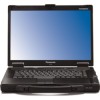Panasonic Toughbook 52 Mapping Technical and Operational Challenges of Mobile - Page 6
Iii. Segmenting Mobile Workers - mount
 |
View all Panasonic Toughbook 52 manuals
Add to My Manuals
Save this manual to your list of manuals |
Page 6 highlights
III. SEGMENTING MOBILE WORKERS "The customers who go with a rugged solution are typically those who have deployed commercial-grade solutions in the past and experienced the soft costs of downed equipment, continuous upgrades, etc." - Tier I Wireless Carrier When it comes to determining the optimal mobile computer, many evaluators underestimate the risks associated with the deployment environment. This fault is most common among first time adopters of mobility who fail to consider device durability and deploy solutions without consideration of the soft costs. According to VDC Research, of respondents who deployed solutions to non-carpeted environments, 37.8% deployed commercial-grade solutions. Of this group, 61.7% did not evaluate semi-rugged or fully rugged solutions. However, and perhaps most interestingly, most users of rugged or durable/business rugged mobile solutions initially adopted commercial grade hardware. In other words, having experienced the pain of high rates of failure, they took a more proactive approach with subsequent deployments. As the various levels of ruggedness and protection have evolved so are the users who frequently rely on mobile computing solutions to support their workflows. This large user base - over 80 million mobile workers in the United States alone - ranges from campus mobile workers (corridor warriors, to road warriors and mobile field workers. Mobile computers used by these professionals are, to varying degrees, exposed to a variety of environmental conditions. In addition, a non-deskbound workforce is simply more prone to mishaps. If equipped with the wrong device, the impact of failure and subsequent downtime can be significant. Included among the core mobile user segments are: • Field-based harsh: Field-based computing is perhaps the roughest on the device due to the need for the computer to be used both inside and outside the vehicle. Therefore along with all the specifications against vibration, temperature, humidity, and altitude, mobile devices for field based computing in harsh environments need to be built to withstand wet and particulate laden environments, including dust, sand, dirt, snow, ice, and rain. Finally, the solutions need to be built to withstand potential long falls to a variety of surfaces. Solutions deployed to these environments are typically classified as fully rugged solutions. Common adopters include the military, utilities, marine and trucking industries. • In-vehicle: Devices are exposed to a variety of hazards within the vehicle including vibration, dust, humidity, temperature, thermal shock, and altitude. The areas where vehicles are driven is one of the largest factors determining the degree of ruggedness for the device. In the case of off-road driving, devices can experience shock equal to a drop to concrete. Mounts for solutions also need to be ruggedized depending on the environmental demands. Common adopters of in-vehicle computers include police, utility workers, and the military. © 2009 VDC Research Group, Inc. 5















